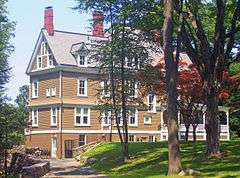Walker House (Garrison, New York)
|
Walker House | |
|
East (front) elevation and south profile, 2008 | |
| Location | Garrison, NY |
|---|---|
| Coordinates | 41°22′23″N 73°56′01″W / 41.37306°N 73.93361°WCoordinates: 41°22′23″N 73°56′01″W / 41.37306°N 73.93361°W |
| Area | 4 acres (1.6 ha)[1] |
| Built | 1885[1] |
| Architectural style | Queen Anne |
| MPS | Hudson Highlands MRA |
| NRHP Reference # | 82001256 |
| Added to NRHP | November 23, 1982 |
The Walker House in Garrison, New York, United States, is located on New York State Route 403, between Routes 9 and 9D. It is a large Queen Anne-style house constructed in 1888.
Samuel Sloan was a prominent 19th century railroad magnate, best known for his 32-year tenure as president of the Delaware, Lackawanna & Western Railroad. He and his wife, Margaret Elmendorf Sloan, purchased large tracts of land in Garrison, New York before and after the Civil War. They built their summer estate, Oulagisket (later renamed Lisburne Grange by his son), in Garrison in 1864. Sloan and his wife built the Walker House on their Garrison estate near Oulagisket in 1888. It was a wedding gift to their daughter, Elizabeth La Grange Sloan (1862 - 1960), upon the occasion of her marriage on April 27, 1887 to Joseph Walker, Jr. (1858 - 1927). Walker became a senior partner and president of the investment banking firm of Joseph Walker & Sons and member of the New York Stock Exchange. In 1982 both the Walker House and Oulagisket were added to the National Register of Historic Places as part of the Hudson Highlands Multiple Resource Area.
Building
The Walker House is situated on a four-acre (1.6 ha) lot. It is surrounded by tall trees; the deep ravine created by Arden Brook as well as the steep slope of Fort Hill elevate the house above the road and, together, partially obstruct the view of the house from it. A driveway curves up the slope from the east to the front facade.[1]
The building itself is a three-story frame home on a brick foundation with several nested roofs shingled in slate, together with a copper porch roof. The wraparound porch extends across the front of the house and around most of the west side and part of the east side. The steeply-pitched main roof is done in a chateau style with eyebrow vents on all sides; the original crockets on the gable ridges were removed when the original slate roof was replaced with new slates in 2001-2002.[1]
Three large brick chimneys pierce the extensions to the north and south, and a polygonal bay extends further from the north. A veranda with turned posts and corner brackets extends around three sides of the struct.[1]
History
Railroad magnate Samuel Sloan, whose own estate, Oulagisket, is nearby, had the house built for Elizabeth La Grange Sloan, one of his daughters, as a wedding present in 1888. An 1891 map of the area shows the house and names its occupant as "Mrs. Walker".[1] At the time of its construction, it was located on the Sloan family estate, together with Oulagisket and numerous other Sloan out-buildings. It adjoins Wyndune, also built by Samuel Sloan as a wedding present for another daughter, Margaret Elmendorf Sloan (1854 - 1906), when she married the Rev. Joseph Rankin Duryee (1853 - 1935). The original Sloan estate has been divided over the years; its various out-buildings have all been converted to residential use; and all are now under separate ownership.
The house remained in the Walker family until 1956, when it was sold to Walker O. and Abby H. Cain. Walker O. Cain (no known relation of Joseph Walker), a prominent twentieth-century architect, practiced at McKim, Meade & White, which firm was ultimately succeeded by his own firm, Walker O. Cain Associates. Since the house had been a summer residence when owned by the Walkers, modern mechanical services were added to the house after the 1956 sale to make it usable year-round. The house was later sold again in 2000 and then in 2005. Following both the sale in 2000 and that in 2005, the house was extensively renovated and updated. In 1978, the railing from the widow's walk on top of the roof was removed because of its general deterioration, but kept in storage for possible future restoration. The widow's walk was completely rebuilt and reinstalled in 2012. Because of the fact that only two families (the Walkers and then the Cains) successively owned the house for over 100 years, many original period details remained intact and were preserved in later restorations.
References
- 1 2 3 4 5 6 Sharp, L. Corwin (August 30, 1979). "National Register of Historic Places nomination, Walker House". New York State Office of Parks, Recreation and Historic Preservation. Retrieved May 5, 2009.


